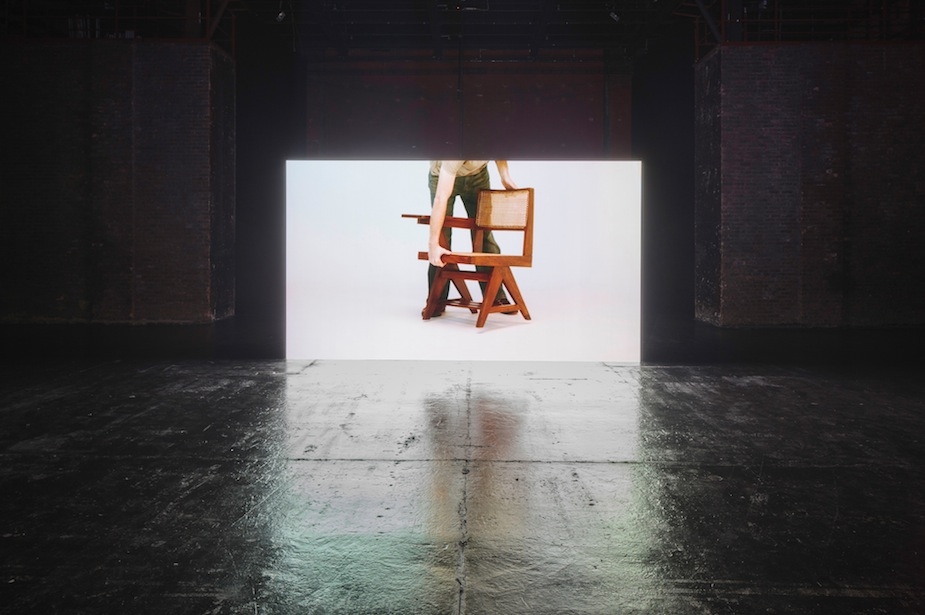In Glasgow, once a global trading port for ship-building and textiles, the shift from heavy industry to the creative industries is a sensitive subject, but one that is sympathetically charted for this, the seventh edition of Glasgow International. Described as having ‘a loose theme considering the legacy of industry’, the programme, directed by Sarah McCrory, sees 15 artists, 11 of whom are women, make use of assorted sites across the city, including the dilapidated former festival hall, the steamy yet serene Botanic Gardens, the ornate Mitchell Library and the more traditional exhibition spaces of GoMA, Tramway and Kelvingrove Museum, all of which were constructed as a result of the city’s industrial might. Across eight venues, the programme’s mix of local and international artists employ an array of both handmade and industrial materials and processes, considering what it means to labour, to harvest and to yield, and exploring ideas around the production of value and the resurgence of craft.
At Tramway, Amie Siegel’s film Provenance (2013) provides a pensive consideration of art-market economies. Taking the famed modernist furniture designed by Le Corbusier and Pierre Jeanneret for Chandigarh as a starting point, Siegel maps the increasing fetishisation of these once-utilitarian objects as they move from offices and rooftops in India, through upholstery workshops (where they are covered in linen, velvet, fur…), to auction rooms, superyachts and collectors’ homes. With tidy circularity, Siegel then doubles back on herself with a second film – documenting the auction of the first – as it becomes yet another marketable commodity. Nearby, in a surreal complication of labour and excess, Mika Rottenberg presents two visceral films in which pearls are force-cultivated, lettuces are pulverised and rubber is leached from trees by a production line of anonymous women. Behind which, Sheila Hicks’s Mighty Mathilde and Her Consort (2016), an enormous web of coloured fibres, exudes from ceiling to floor, depositing pillowy boulders at its base and clogging the disused tramlines with bright wisps of wool.
At Kelvin Hall – the neglected home of Glasgow’s 1951 Exhibition of Industrial Power, and subsequent annual circuses and carnivals – Claire Barclay’s vast, and pungent, Bright Bodies (2016) sits atop a climb of peeling staircases. Drawing on the building’s history, Barclay uses industrial materials (steel, rubber, sheet metal and coal tar) to create a bondage-esque appropriation that at times resembles twentieth-century abstract sculpture and, at others, circus paraphernalia. Red canvas sacks enclosed in steel cages, swathes of pink rubber surrounding a lake of coal tar and machine-drilled sheet metal all recall the celebration of steel and coal that occurred in this very building, as well as the annual circus festivities that Barclay remembers from here as a child.
Any emphasis on the industrial is offset at the Botanic Gardens, where Aaron Angell’s rickety ceramic sculptures flourish among the begonias whose glasshouse they share. Inspired by a disparate range of influences, from medievalism to the eighteenth-century landscape architect Capability Brown, Angell’s semipastoral dioramas – composed of tiny clay bricks, wonky pipes, flowers, watermills, ladders and church organs – advocate the intimacy of the handmade over the mass-produced. Tamara Henderson’s Seasons End (2016) at the Mitchell Library accentuates this attitude. A pantheon of costumed figures, resembling scarecrows or totemic beings in hand-sewn kimonos, feel like members of an overlooked pagan group. Led by two central figures – Body Fountain Fetch, a recumbent blue female(?) whose body constitutes a chaise longue and whose head is made of water-filled pipes; and Garden Photographer Scarecrow, a giant patchwork man(?) with an embroidered fruit face – this community of beings, who feel both pre- and postindustrial, seem to be celebrating harvest and nature, as much as craft itself.
More anthropomorphic textiles inhabit GoMA’s lower galleries, where Cosima von Bonin’s Who’s Exploiting Who in the Deep Sea? (2006–2016) presents a fete of fish out of water. Boisterous, scaled-up sea creatures (a languorous lobster, mischievous clams, a bored shark) are accompanied by prerecorded footage of a drag dance-off in an installation that literally plays with ideas around costume, performance and popular culture. With a strikingly different energy to other works in the programme, von Bonin’s melancholy yet humorous creatures also seem to present a contrast to the prevailing theme of industry in the surrounding exhibitions. Upstairs at GoMA, however, recent Glasgow School of Art graduate Tessa Lynch maintains von Bonin’s playful approach to the everyday, presenting an abstracted description of her daily commute. Taking advantage of the snaking gallery, her elegant installation portrays the colours and patterns of Glasgow’s particular stonework and facades with a dexterity that combines both craft and industrial technique. Here the programme finds a climax, celebrating both Glasgow’s illustrious heritage as well as its cultural future in a way that is sensitive, forward-thinking and sassy. The pairing of Lynch and von Bonin is satisfyingly awkward and happily discordant.
Various venues, Glasgow, 8–25 April 2016
This article first appeared in the Summer 2016 issue of ArtReview
